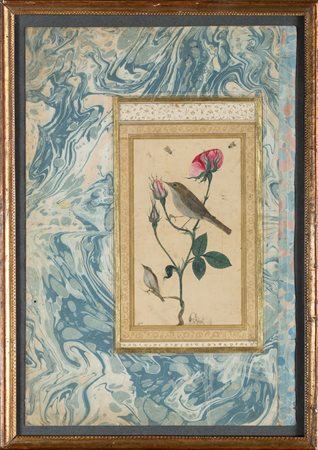 Capitolium Art - Via Carlo Cattaneo 55, 25121 Brescia
Capitolium Art - Via Carlo Cattaneo 55, 25121 Brescia
ASTA 210 - FINE CHINESE, ISLAMIC & ASIAN ART TERZA SESSIONE
venerdì 16 dicembre 2016 ore 18:00 (UTC +01:00)
Arte Islamica Pagina di album illustrata ed illuminata firmata da 'Abdullah...
Arte Islamica Pagina di album illustrata ed illuminata firmata da 'Abdullah Bukhari
Turchia, dinastia Ottomana, XVIII secolo
Gouache e oro su carta . -. Cm 15,00 x 26,50. Pregevole dipinto raffigurante sul fronte due usignoli su un ramo di rosa con insetti sopra di loro e sul retro una pagina composita raffigurante due uomini impegnati in una conversazione e due rose di diversa altezza. Entrambe con margini effetto marmorizzato, il fronte entro cornice con arabeschi dorati, il retro con due pannelli con fiocchi dorati. Firmato sul fronte in basso a sinistra.
'Abdullah Bukhari (attivo 1725 - 50) fu uno dei più famosi pittori turchi del XVIII secolo, specializzato in album di fiori, come questo esemplare, e nella ritrattistica femminile. Egli fu pittore di corte per il sultano Ahmed III (r.1703 - 30) durante l'epoca chiamata "Era dei Tulipani" per la mania che spingeva i membri della corte e i cittadini benestanti a spendere cifre folli anche solo per un singolo bulbo raro.
41 X 28 cm
47 X 33 cm con cornice
Arte Islamica An illustrated and illuminated double sided album page signed by 'Abdullah Bukhari
Ottoman Turkey, 18th century
Gouache and gold on paper . . Cm 15,00 x 26,50. Fine painting depicting, on the front, two nightingales resting on a rose branch, with insects above them, and a composite page with two men engaged in conversation and two roses of different heights on the back. Both sides present edges with marble effects, the front within a frame with golden arabesques, and the rear with two panels with golden ribbons. Signed on the front, in the lower left side. Abdullah Bukhari (active between 1725 and 1750) was one of the most famous Turkish painters of the XVIII century, specializing in floral albums, and in female portraits. He was the court painter for the sultan Ahmed III (reigning between 1703 and 1730), during the period referred to as “Tulip Era”, for the habit of court members and rich individuals of spending enormous sums of money even for a single rare tulip bulb.
41x28 cm
47x33 cm with frame




